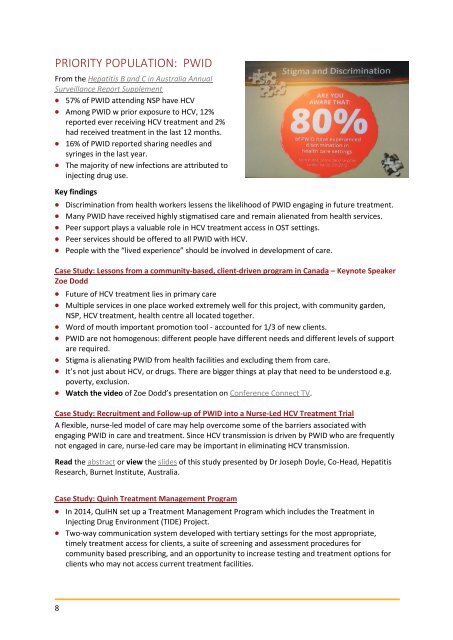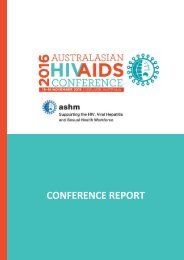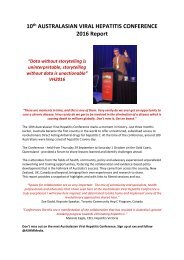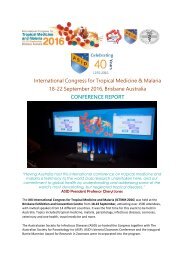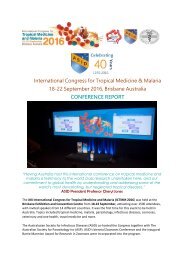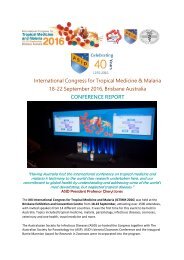ASHM_VH2016_Report_FINAL
Create successful ePaper yourself
Turn your PDF publications into a flip-book with our unique Google optimized e-Paper software.
PRIORITY POPULATION: PWID<br />
From the Hepatitis B and C in Australia Annual<br />
Surveillance <strong>Report</strong> Supplement<br />
• 57% of PWID attending NSP have HCV<br />
• Among PWID w prior exposure to HCV, 12%<br />
reported ever receiving HCV treatment and 2%<br />
had received treatment in the last 12 months.<br />
• 16% of PWID reported sharing needles and<br />
syringes in the last year.<br />
• The majority of new infections are attributed to<br />
injecting drug use.<br />
Key findings<br />
• Discrimination from health workers lessens the likelihood of PWID engaging in future treatment.<br />
• Many PWID have received highly stigmatised care and remain alienated from health services.<br />
• Peer support plays a valuable role in HCV treatment access in OST settings.<br />
• Peer services should be offered to all PWID with HCV.<br />
• People with the “lived experience” should be involved in development of care.<br />
Case Study: Lessons from a community-based, client-driven program in Canada – Keynote Speaker<br />
Zoe Dodd<br />
• Future of HCV treatment lies in primary care<br />
• Multiple services in one place worked extremely well for this project, with community garden,<br />
NSP, HCV treatment, health centre all located together.<br />
• Word of mouth important promotion tool - accounted for 1/3 of new clients.<br />
• PWID are not homogenous: different people have different needs and different levels of support<br />
are required.<br />
• Stigma is alienating PWID from health facilities and excluding them from care.<br />
• It’s not just about HCV, or drugs. There are bigger things at play that need to be understood e.g.<br />
poverty, exclusion.<br />
• Watch the video of Zoe Dodd’s presentation on Conference Connect TV.<br />
Case Study: Recruitment and Follow-up of PWID into a Nurse-Led HCV Treatment Trial<br />
A flexible, nurse-led model of care may help overcome some of the barriers associated with<br />
engaging PWID in care and treatment. Since HCV transmission is driven by PWID who are frequently<br />
not engaged in care, nurse-led care may be important in eliminating HCV transmission.<br />
Read the abstract or view the slides of this study presented by Dr Joseph Doyle, Co-Head, Hepatitis<br />
Research, Burnet Institute, Australia.<br />
Case Study: Quinh Treatment Management Program<br />
• In 2014, QuIHN set up a Treatment Management Program which includes the Treatment in<br />
Injecting Drug Environment (TIDE) Project.<br />
• Two-way communication system developed with tertiary settings for the most appropriate,<br />
timely treatment access for clients, a suite of screening and assessment procedures for<br />
community based prescribing, and an opportunity to increase testing and treatment options for<br />
clients who may not access current treatment facilities.<br />
8


